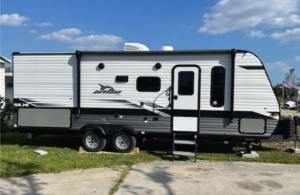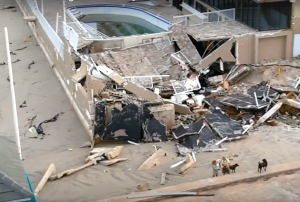Improvements noted, but more needed
The Florida Legislature is also continuing its work on disaster recovery efforts from last year’s Hurricanes Ian and Nicole and now the recent Hurricane Idalia from August 30. The House Select Committee on Hurricane Resiliency & Recovery met last Monday to hear a progress report directly from Florida’s emergency management chief and then hosted a panel discussion by local governments impacted by Ian and Nicole.

Florida Emergency Management Director Kevin Guthrie. Courtesy, The Florida Channel
Florida Director of Emergency Management Kevin Guthrie reported that SB 4-A, the legislature’s hurricane relief and recovery measures passed in the December 2022 special session, along with various Executive Orders have all helped tremendously – including streamlining the permitting processes necessary for rebuilding. This streamlining not only allowed for faster reimbursements from FEMA for local governments, but also allowed for “one-stop” processing by state agencies working in concert with local governments to ensure reconstruction contractors possessed the necessary skills.
Guthrie proudly reported that his agency has successfully awarded all of the specific “gap funding” appropriation of $350M to 23 applicants; $291M was provided as loans and $59M was distributed as grants. While he said they were efficient in administering the program, the need exceeded the resources allocated as there were more than 400 funding applications totaling over $1 billion. (View his full presentation.)

A FEMA travel trailer from Hurricane Ian. Courtesy, Florida DEM
Guthrie told the committee that the Division of Emergency Management (DEM) is creating a publicly-available database that will show how it administers funding from federal, state and local sources – where it comes from and how it is distributed. FEMA projects will be indexed by assignment project numbers, too, all part of a major overhaul of DEM’s IT systems that Guthrie said has already helped them respond more quickly to recent storms. He also reminded members that some of the financial support programs that have been funded by FEMA will expire on Jan 31, 2024, specifically the travel trailer program providing temporary housing for displaced residents. That includes trailers for property owners so they can live on their own land during recovery, something Guthrie said is governed by federal law and that DEM has no way to extend it.
Rep. Anna Eskamani (D-Orlando) shared a concern by local governments that they could not receive any reimbursement funding until all audits are complete. Guthrie shared his frustration – noting that he was aware of one municipality that was waiting because there was a single truck of debris that could not be accounted for in the audit. He recognized the need for some process reform and pledged to work with the committee to find solutions.

Storm surge from Hurricane Nicole washes out a Volusia County condominium building seawall and swimming pool, November 12, 2022. Courtesy, Volusia County
The Committee then heard from representatives of five counties from both coasts on their recovery experiences. There was a repeated theme by all reflected in the Collier County presentation (page 14): they were very thankful how rapidly the DEM responded with assistance for Nicole, Ian and Idalia. They often referred to new capabilities and processes made available through passage of SB 4-A, allowing DEM to step-up while still awaiting FEMA aid, and the success of the travel trailer program, although they expressed frustration over its funding limitations. Flagler County’s representative thanked the legislature for its $100 million appropriation for beach restoration, but said it was still insufficient to meet a fraction of the total lost in all three storms on both coasts. He noted the success of the recently expanded My Safe Florida Home wind mitigation program and wondered if DEM has considered creating a parallel program that identifies flood risk factors and mitigation for homeowners.
Other ideas discussed for future consideration include creating regional emergency response centers among smaller, financially-constrained counties; including cellphone tower providers in future efforts to fortify service; and creating regional resource centers among counties that don’t have as many schools that normally host emergency evacuation centers. There was sentiment that the building code for seawalls – especially for coastal dwellings – may have to be reviewed, considering how many failed.
LMA Newsletter of 10-23-23

